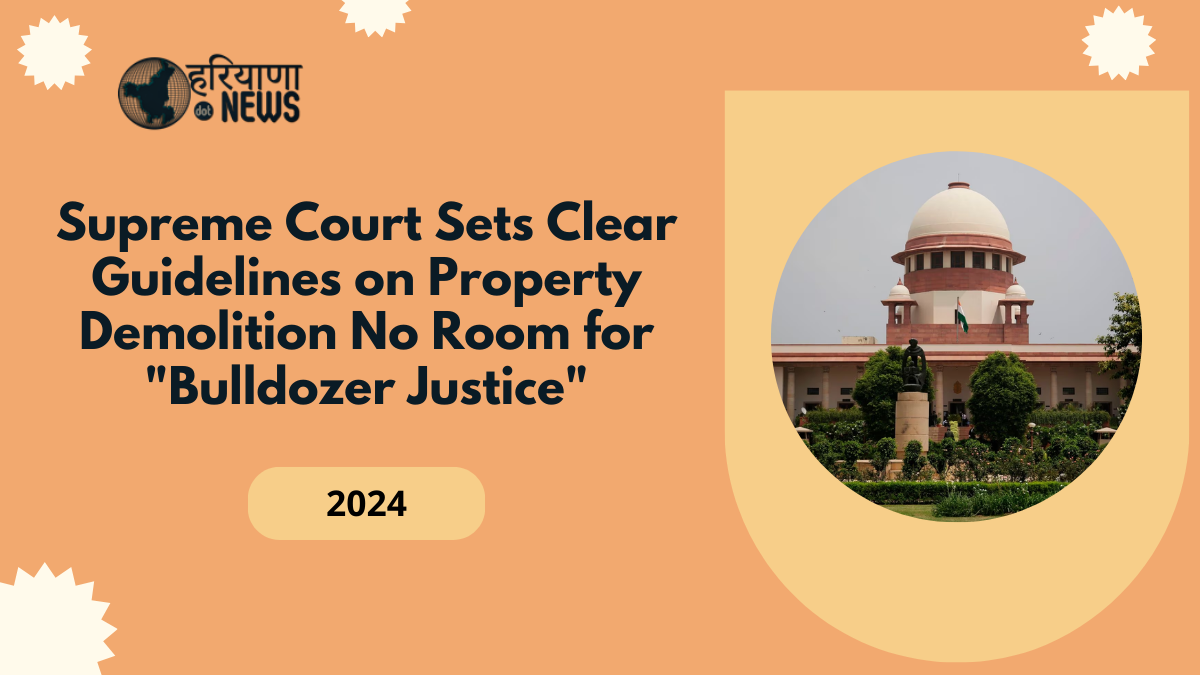In a strong stance against indiscriminate demolitions, the Supreme Court has issued guidelines for authorities, condemning the practice of “bulldozer justice.” This term refers to instances where properties are destroyed simply because the owner faces criminal accusations. The Court emphasized that public officials who engage in such demolitions must be held accountable.
Executive Cannot Bypass the Rule of Law in Property Demolitions.
A bench comprising Justices B.R. Gavai and K.V. Viswanathan stated that the executive branch does not have the authority to declare anyone guilty or take punitive actions against them. The bench underscored that demolishing property based solely on allegations is a direct violation of the rule of law, which ensures that individuals are protected from arbitrary property seizures. The justices warned against the executive taking on judicial roles by unilaterally punishing accused individuals.
Rule of Law Demands Fair Notice and Time to Prepare
The Court pointed out that the rule of law provides a sense of security, assuring individuals that their property will not be unjustly taken. Even if occupants choose not to dispute a demolition order, authorities must provide sufficient time for them to vacate and make necessary arrangements. The Court stressed that it is distressing to see vulnerable people, including women, children, and the sick, suddenly forced out of their homes. The bench noted, “Heavens would not fall on the authorities if they hold their hands for some period.”
Supreme Court Guidelines on Property Demolition
To prevent misuse of demolition orders, the Supreme Court has established a list of guidelines to be followed by authorities before any property demolition:
Advance Notice and Opportunity to Contest
Authorities must issue a fair warning to residents, giving them adequate time to either challenge the decision or vacate the property. This notice period may only be bypassed if the structure directly obstructs essential public utilities, such as roads, water channels, or railway lines.
Show Cause Notice Requirement
A show cause notice must be sent to the property owner before any demolition can occur. This notice should be visibly posted on the property and give the owner 15 days to either contest the order or vacate the premises.
Digital Record and Confirmation of Notice
To avoid claims of tampering with notice dates, the Court instructed that the notice, once delivered, must also be forwarded to the office of the Collector or District Magistrate electronically. An automated confirmation email should be generated to confirm receipt.
Opportunity for Personal Hearing
The issuing authority must grant the property owner a chance for a personal hearing. Detailed minutes of this hearing should be recorded, and the final order must explicitly state why demolition is necessary in this particular instance.
 Mumbai Police Detain Woman for Threatening Call on Prime Minister Modi’s Life
Mumbai Police Detain Woman for Threatening Call on Prime Minister Modi’s Life
 Hemant Soren was sworn in as the Chief Minister of Jharkhand for the fourth time, took oath as Jharkhand’s 14th chief minister
Hemant Soren was sworn in as the Chief Minister of Jharkhand for the fourth time, took oath as Jharkhand’s 14th chief minister
 India’s Strategic Breakthrough: Advancing SLBM Capabilities with INS Arighaat
India’s Strategic Breakthrough: Advancing SLBM Capabilities with INS Arighaat
 Chinmoy Das Arrest: High Court Petition Seeks Ban on ISKCON Amid Rising Violence Against Hindus in Bangladesh
Chinmoy Das Arrest: High Court Petition Seeks Ban on ISKCON Amid Rising Violence Against Hindus in Bangladesh
 Bangladesh Police Use Tear Gas and Batons Against Hindu Protesters After Chinmoy Das’ Arrest
Bangladesh Police Use Tear Gas and Batons Against Hindu Protesters After Chinmoy Das’ Arrest





Right to Correct Unauthorized Construction
Before demolition proceeds, the owner should be given an opportunity to address any unauthorized structures. Authorities must allow a minimum of 15 days before carrying out demolition.
Demolition Scope Limited to Unauthorized Areas
Only the illegal or unauthorized sections of the property should be demolished. Authorities must compile a detailed report before beginning any demolition, with the entire process recorded on video for transparency and accountability.
Liability for Non-Compliance with Guidelines
If the demolition process fails to adhere to the Court’s guidelines, those responsible, including public officials, will be personally liable for restoring the property and covering all associated costs.
Conclusion
These comprehensive guidelines by the Supreme Court establish a fair and regulated approach to property demolition, safeguarding citizens’ rights while holding authorities to account. This ruling aims to reinforce the principles of the rule of law, ensuring that demolition practices remain just and transparent.
Click here to know more.






